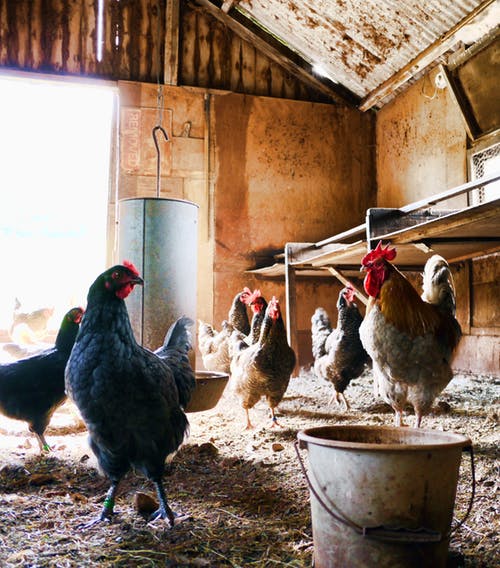By now, most of us already know the different names of chickens according to sex. A fully-grown male chicken is known as a rooster, which crows and is more aggressive towards potential predators and other roosters that pose a threat. A fully-grown female, on the other hand, is known as a hen. Hens lay eggs on nearly a daily basis.
We know that baby chickens are known as chicks, but did you know that there are terms to describe young chickens according to sex? As birds develop, their sex becomes much more obvious and make them easier to tell apart. And with new primary feathers developed, they also take on new names.
Young Chicken Names

A “pullet” is the term for a young female chicken less than a year old, while a young male chicken is called a “cockerel.” While chicks are still young, it is difficult to distinguish them between sexes because they haven’t developed the features that separate roosters from the hens.
By five to seven weeks, a chick should begin to develop early traits associated with their sex, and from there you can begin to tell whether or not the chick is a pullet or a cockerel. Because roosters have bigger combs and wattles than hens, their sprouting combs are usually the first sign to develop that can help you determine their sex. Cockerels will also have noticeably bigger tail feathers while pullets will have longer flight feathers on her wings. By the time cockerels learn to crow, the sexes of a group of chicks should be distinguishable.
Cockerel/Rooster

A rooster, also known as a cock, is an adult male chicken. Its younger counterpart is a “cockerel.” The term “rooster” originated in the United States as a euphemism from Puritans after the term “cock” began to have sexual connotations. They were called roosters after the fact that these chickens would be seen “roosting,” which is the act of being perched aloft to sleep during the day.
Roosters are polygamous and will mate as many hens as possible in one day. While roosters do not have any male genitals, they transfer sperm cells to hens to reproduce through means of the cloacal kiss, a process where they connect their cloaca (the opening under their tails used for excretion and reproduction).
Roosters are very protective of their brood. If they are the only rooster that can mate with all the hens in a certain area, he will assume that all of the hens’ nests with eggs are his, so he guards the general area against predators and other roosters trespassing onto his territory. Roosters also have a tendency to stay in high places and serve as a lookout for his brood.
Pullet/Hens

A ‘pullet’ is a young female chicken under one-year-old that may or may have not started laying eggs. Because the term “hen” is based on a female chicken’s age, a chicken can already be laying eggs at five months old but can still be called a “pullet.”
Pullets will have a full coat of shiny new feathers. They can reach sexual maturity as early as four months old when they finally lay their first eggs. However, this isn’t an exact time frame and can vary between chicken breeds.
Capons
A third and type of chicken is called a “capon,” but this is a type of chicken that doesn’t come naturally and requires human interference in a rooster’s anatomy. A young cockerel can grow into a capon if it is castrated at a young age (a process where they are “caponized”) and then left to mature.
When they mature, they do not develop some rooster features and instead take on traits seen in plump hens. A capon can look confusing since they have the plumage, feet, and wattle of a rooster, but the plump body of a hen.
Capons are created by farmers for the purpose of food production. While a capon matures, they end up becoming fatty. Once it reaches a certain size, the capon is slaughtered and their meat is sold at a higher price compared to other chicken body parts because its fat makes the meat more tender and flavorful.
How to Tell Male and Female Chickens Apart
About half of the chickens that are hatched are pullets while the other half are cockerels. The easiest way to determine a chicken’s sex is to see if they either start crowing or lay an egg, but this could take weeks for their traits to develop.
Body and Legs
Cockerels will develop bigger bodies and thicker legs than pullets, who take on a softer and smaller shape. When comparing chicks of roughly the same age, cockerels will appear much larger and have bigger legs.
Combs and Wattles
Cockerels’ combs are more developed and larger than pullets’ combs because roosters will always have larger ones than hens (unless they were caponized at a young age). Cockerels’ combs also turn red faster than pullets’ during development. Pullets’ combs may flop over because of its size, but a cockerels’ combs will always stand upright. You may also notice that a cockerel’s comb is sharper than a pullet’s soft comb.
Feathering
Cockerels will have sharp and edgy-textured feathers on their necks while Pullets have rounded, softer feathers on theirs. Because of their fine feathers, hens’ feathers can get damaged if they mate often with roosters that pull on their necks.
To recap, young chickens also have other names (apart from the general name “chicks”) based on their sex. Young female chickens are pullets and will start to reach maturity at around four weeks, while young male chickens are cockerels until they mature at around six weeks. If you’re raising young chickens, it is best to take care of younger chickens like you would chicks until such time that they begin to show signs of sexual maturity and can start to be treated like fully grown chickens.

